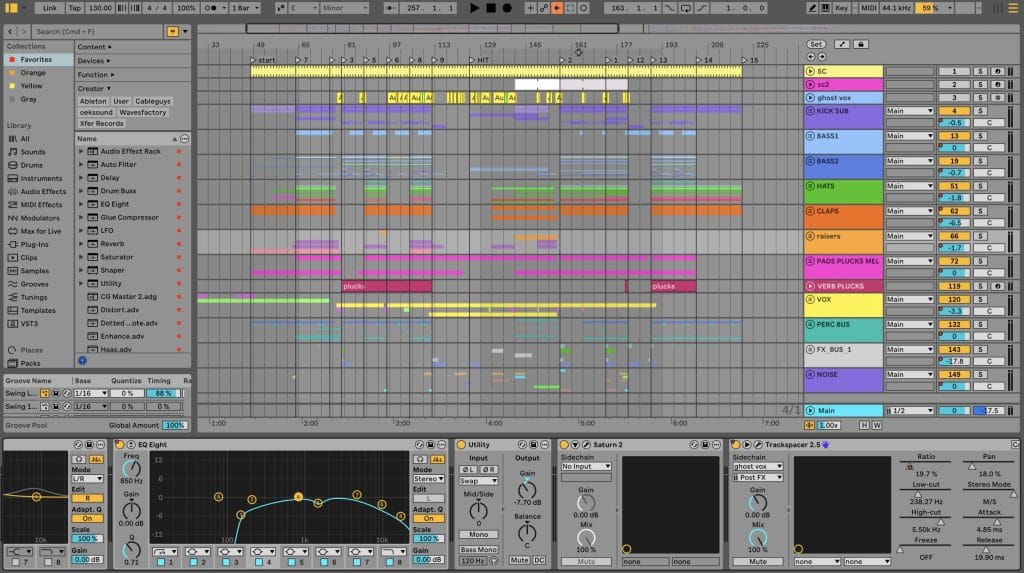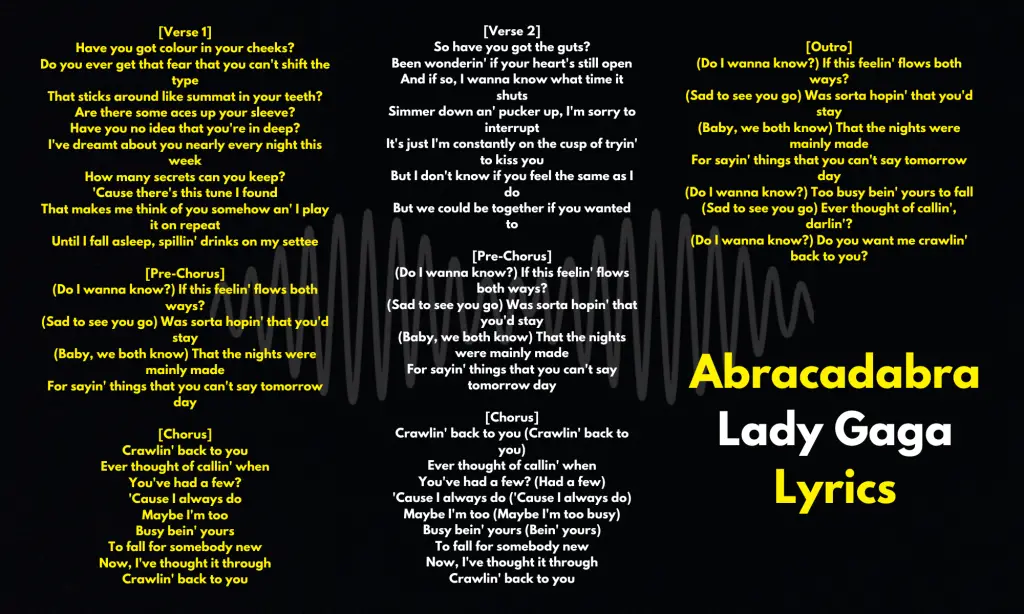Table of Contents
Image Credit: Lady Gaga, “Abracadabra”
Courtesy Photo
So, Lady Gaga just dropped “Abracadabra” in the middle of a Grammys commercial break—not a stage performance, not a dramatic awards show moment, but an ad. And yet, within minutes, fans were losing their minds. The song, a fast-tempo dance track off her upcoming album Mayhem, immediately set the internet on fire, not just because it’s catchy, but because it’s weird in that classic, theatrical Gaga way.
The music video?
A full-blown dance battle between the forces of light and darkness, complete with Gaga in thorn-covered costumes and an army of dancers moving like they’re possessed. Even the press release described it as a showdown between two sides of Gaga, with nods to her Lady in Red imagery woven throughout.
The song is packed with imagery of angels demanding a toll, circles being drawn in the clouds, and the devil turning around—which, let’s be honest, all sound more like something out of a medieval alchemy book than a standard pop track.
That’s why I wanted to take a closer look at what’s really going on beneath the surface. Using my background in English literature and creative writing, I’ll be breaking down these lyrics through a more poetic lens, drawing connections to the kind of themes we see in classic literature, modern fantasy, and even old mystical traditions. This is just my take, but if you’re curious about what “Abracadabra” might really be summoning, let’s get into it.
Lady Gaga’s “Abracadabra” at a Glance
- It’s a dance track, but with heavy mystical vibes. Gaga repeats “Abracadabra” like an incantation, hinting at a deeper, almost ritualistic meaning.
- The music video is a literal battle between light and dark. Gaga takes on multiple personas, dressed in angelic white one moment and blood-red the next.
- Lyrically, it plays with themes of power, fate, and unseen forces. The references to paying a toll to angels and the devil turning around suggest something much bigger than just a party anthem.
Abracadabra Lyrics
Abracadabra Meaning
“Abracadabra, Abracadabra”
Right away, the song starts with repetition—“Abracadabra, Abracadabra.” This isn’t just a random phrase; it’s a word that has been used for centuries in magic, spells, and rituals. By repeating it over and over, the speaker isn’t just saying something—they’re doing something. They’re calling on a force, trying to make something happen.
This reminds me of Christopher Smart’s Jubilate Agno, where he uses repetition in a way that feels almost like a chant:
“For I will consider my Cat Jeoffry.
For he is the servant of the Living God duly and daily serving him.”
Smart repeats “For” again and again, turning simple words into something bigger, something sacred. The song does the same thing. By saying “Abracadabra” over and over, the speaker is setting the stage for something mystical, something beyond normal life.
James Merrill does something similar in The Book of Ephraim, where he tries to communicate with spirits through a Ouija board. Like the song, his writing blurs the line between words and magic. The message here is clear: words have power, and saying them again and again gives them even more strength.
“Pay the toll to the angels”
This is an interesting line because we usually think of angels as kind and giving. But here, they aren’t just offering help—they’re asking for payment. This suggests that reaching something higher, something spiritual, costs something. Whether it’s wisdom, enlightenment, or even redemption, you don’t get it for free.
Paul Valéry talks about this kind of struggle in Le Cimetière Marin. He writes:
“The wind is rising! … We must try to live!”
He’s saying that life keeps moving, and if we want to grow or understand more, we have to try. It takes effort. The song’s lyrics reflect this same idea. If you want something greater—if you want to reach the angels—you have to give something up in return.
This also reminds me of Merrill’s poetry, where he’s constantly seeking knowledge from the spirit world but has to work for it. He asks questions, waits for answers, and follows strict rituals. It’s never easy. The song’s line suggests that same idea: if you want something beyond yourself, be ready to pay for it.
“Drawin’ circles in the clouds”
This line is one of the most powerful in the song. Circles are ancient symbols of infinity, wholeness, and cycles. But these circles aren’t drawn in stone or on the ground—they’re in the clouds. That means they’re temporary, impossible to hold onto. It’s like trying to grab something bigger than yourself, something you can’t ever fully understand.
James Merrill’s The Book of Ephraim explores this idea, too. At one point, he writes:
“This is not speech but a prolonged silence.”
He’s trying to communicate with spirits, but he knows that true understanding will always be just out of reach. The song’s lyrics suggest the same struggle—trying to make sense of something greater, but knowing it will always slip away.
Christopher Smart also wrestles with this idea in Jubilate Agno, where he writes:
“For the heavens are higher than the earth, and yet they are measured.”
He’s saying that we can try to understand the divine, but we’ll never fully grasp it. The song reflects this same idea. Drawing circles in the clouds is an act of faith, of hope, even when you know they won’t last.
“Keep your mind on the distance / When the devil turns around”
This line feels like a warning. “Keep your mind on the distance” tells us to stay focused on where we’re going. It suggests that if we look too closely at the dangers around us, we might get pulled off course. Then we get “when the devil turns around.” This makes it clear that something dark is watching, and if we’re not careful, we could be drawn in.
Paul Valéry’s poem speaks to this kind of struggle:
“A soul under the sky, weightless, at rest—
What endless calm!”
He’s describing what it would be like to be free from distractions, to stay on the right path. But the truth is, that’s hard to do. The devil, in the song, could represent temptation, doubt, or fear. The warning is clear: don’t get caught up in it.
This reminds me of Merrill’s work, too. He often writes about being drawn toward the unknown, but the risk that comes with it. The song’s lyrics echo that same caution—if you want to keep moving forward, don’t let the darkness pull you in.
Connecting All The Dots
If “Abracadabra” makes one thing clear, it’s that words have power—say something enough times, and it starts to feel real. Gaga isn’t just repeating “Abracadabra” for the sake of a catchy hook. She’s leaning into the idea that language itself can create and destroy, summon and command. This is the same idea Christopher Smart plays with in Jubilate Agno, where his obsessive, chant-like verses turn into something almost sacred.
His line, “For the heavens are higher than the earth, and yet they are measured,” gets at the same thing Gaga’s lyrics do—trying to grasp something bigger than yourself, knowing full well you never really can. It’s no accident that Abracadabra has been used for centuries in spells and incantations; the song taps into that history, using words as both a ritual and a weapon.
Then there’s the cost of transcendence—because in this song, nothing comes for free. “Pay the toll to the angels” is one of those lines that lingers. It suggests that reaching something higher—whether that’s power, knowledge, or salvation—requires sacrifice. That’s a concept Paul Valéry wrestles with in Le Cimetière Marin, a poem that constantly questions what it means to chase the infinite.
His line, “The wind is rising! … We must try to live!” carries the same urgency we see in Gaga’s lyrics. Both suggest that movement toward something greater isn’t just about desire—it’s about effort, struggle, and maybe even suffering. In the Abracadabra music video, Gaga doesn’t just sing about this battle—she performs it, literally shifting between the forces of light and dark in a dance that feels more like a ritual than a performance.
And then there’s the warning: “Keep your mind on the distance / When the devil turns around.” That’s the moment in the song where it all shifts—where the spell being cast suddenly feels dangerous. This isn’t just about power anymore; it’s about temptation and distraction, about something watching when you thought no one was looking. This is straight out of James Merrill’s The Book of Ephraim, where he spends the entire poem communicating with spirits, only to realize he might not be in control of the conversation at all. His line, “This is not speech but a prolonged silence,” hits the same eerie note as Gaga’s.
What happens when you call something into being and it actually turns to face you? The song never answers that question outright—but the fact that the music video is framed as a battle suggests the answer might not be pretty.
The post Lady Gaga Abracadabra Lyrics And Meaning: Breaking Down Its Spiritual Undertones appeared first on Magnetic Magazine.






